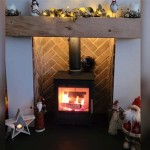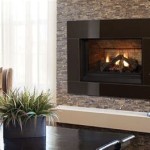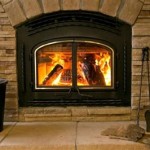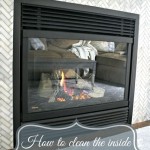The article should includes topics such as: * Benefits of Large Wood Burning Fireplaces * Design Considerations of Large Wood Burning Fireplaces * Installation and Safety * Maintenance and Efficiency * Environmental Impact and Regulations ## The Enduring Appeal of Large Wood Burning Fireplaces
Large wood burning fireplaces represent a significant architectural and functional feature in residential and commercial spaces. Their enduring appeal stems from a combination of aesthetic charm, tangible warmth, and a connection to traditional heating methods. These fireplaces, characterized by their substantial size and capability to accommodate larger logs, offer benefits and present specific considerations that warrant thorough examination.
The use of wood as a fuel source for heating dates back millennia. The modern interpretation of the wood burning fireplace retains the fundamental principles of combustion while incorporating advancements in design and engineering to enhance safety, efficiency, and environmental responsibility. A large fireplace amplifies these aspects, creating a focal point within a room while providing a substantial source of heat.
Benefits of Large Wood Burning Fireplaces
The advantages of incorporating a large wood burning fireplace extend beyond mere aesthetics. They provide tangible benefits in terms of heating capacity, ambiance, and potentially, energy cost reduction. A large firebox allows for the burning of larger logs, resulting in a longer burn time and reduced need for frequent refueling. This is particularly advantageous in colder climates where sustained heating is desired.
One prominent benefit is enhanced heating efficiency. While traditional open fireplaces are known for drawing significant heat up the chimney, modern large wood burning fireplaces often incorporate features such as insulated fireboxes, airtight doors, and controlled air intake systems. These features contribute to more complete combustion and reduce heat loss, thereby increasing the amount of heat radiated into the room. Some models even include heat exchangers that further improve efficiency by circulating air around the firebox and distributing warm air throughout the space.
Furthermore, the ambiance created by a large wood burning fireplace is difficult to replicate with other heating methods. The crackling sound of burning wood, the flickering flames, and the warm glow create a relaxing and inviting atmosphere. This can enhance the overall living experience and provide a focal point for social gatherings. For many, the visual appeal of a large, roaring fire is a primary motivation for choosing this type of fireplace.
In situations where conventional heating systems fail due to power outages, a wood burning fireplace can serve as a reliable backup heat source. This is particularly important in regions prone to severe weather events. The ability to maintain a comfortable temperature without relying on electricity can be a significant advantage in emergency situations.
Finally, the cost effectiveness of a wood burning fireplace depends on the availability and price of wood. In areas where wood is readily accessible and affordable, it can be a less expensive heating alternative compared to electricity, gas, or oil. However, it is essential to factor in the cost of purchasing, storing, and seasoning firewood when evaluating the overall cost effectiveness.
Design Considerations of Large Wood Burning Fireplaces
The design of a large wood burning fireplace requires careful consideration of several factors, including the size and layout of the room, the architectural style of the building, and the desired aesthetic. The fireplace should be proportionally sized to the space to avoid overwhelming the room or appearing undersized. A large fireplace in a small room can be visually dominant and potentially create heating imbalances, while a small fireplace in a large room may not provide sufficient heat or visual impact.
The architectural style of the building should also influence the design of the fireplace. In traditional homes, a large stone or brick fireplace with a prominent mantelpiece may be appropriate. In more contemporary homes, a sleek and minimalist design with clean lines and modern materials may be preferred. The fireplace should complement the overall design of the room and enhance its aesthetic appeal.
The selection of materials is another critical design consideration. Brick, stone, and concrete are commonly used for the firebox and surround due to their heat resistance and durability. The mantelpiece can be constructed from wood, stone, or other materials, depending on the desired aesthetic. The choice of materials should also take into account the overall fire safety of the fireplace.
Ventilation is a crucial aspect of fireplace design. Proper ventilation is essential for ensuring complete combustion and preventing the buildup of harmful gases, such as carbon monoxide. The chimney should be properly sized and constructed to provide adequate draft. In some cases, mechanical ventilation may be necessary to enhance airflow and improve combustion efficiency.
Finally, the design should incorporate safety features to prevent accidental fires and injuries. A fire screen or door is essential for containing sparks and embers. The hearth should extend far enough from the fireplace opening to prevent burning embers from falling onto the floor. The fireplace should also be located away from flammable materials, such as curtains and furniture.
Installation and Safety
The installation of a large wood burning fireplace is a complex process that requires specialized knowledge and skills. It is essential to hire a qualified professional to ensure that the fireplace is installed correctly and safely. Improper installation can lead to serious hazards, including fires, carbon monoxide poisoning, and chimney collapses.
The installation process typically involves several steps, including preparing the site, constructing the firebox and surround, installing the chimney, and connecting the fireplace to the ventilation system. The site preparation may involve reinforcing the floor to support the weight of the fireplace and ensuring that the area is free of flammable materials. The firebox should be constructed using fire-resistant materials, such as firebrick or cast iron. The chimney should be properly sized and constructed to provide adequate draft and prevent the buildup of creosote.
Safety is paramount during the installation process. The installer should follow all applicable building codes and safety regulations. The fireplace should be inspected by a qualified professional before it is used for the first time. It is also essential to install carbon monoxide detectors in the home to provide early warning of potentially dangerous levels of carbon monoxide.
In addition to proper installation, regular maintenance is essential for ensuring the safe operation of the fireplace. The chimney should be inspected and cleaned annually to remove creosote buildup. Creosote is a highly flammable substance that can accumulate in the chimney over time. If left unchecked, it can ignite and cause a chimney fire. The firebox and surround should also be inspected regularly for cracks or damage. Any necessary repairs should be made promptly to prevent further deterioration.
Proper use of the fireplace is also crucial for safety. Only seasoned firewood should be burned in the fireplace. Green or unseasoned wood contains more moisture, which can lead to incomplete combustion and increased creosote buildup. The fireplace should never be overloaded with wood, as this can create excessive heat and increase the risk of a fire. The damper should be fully open when the fireplace is in use to ensure adequate ventilation. The fireplace should never be left unattended while a fire is burning, and all embers should be completely extinguished before leaving the area.
Maintenance and Efficiency
Maintaining a large wood burning fireplace is critical for both safety and efficiency. A well-maintained fireplace will operate more safely, burn more efficiently, and last longer. Regular cleaning and inspection are essential for preventing problems and ensuring optimal performance.
One of the most important maintenance tasks is chimney cleaning. Creosote, a byproduct of incomplete combustion, accumulates in the chimney over time. This substance is highly flammable and can cause dangerous chimney fires. The National Fire Protection Association (NFPA) recommends that chimneys be inspected and cleaned annually by a qualified chimney sweep. The frequency of cleaning may vary depending on the amount of wood burned and the type of wood used.
In addition to chimney cleaning, the firebox and surround should be inspected regularly for cracks or damage. Cracks can allow heat to escape and reduce the efficiency of the fireplace. Damaged firebricks should be replaced promptly to prevent further deterioration. The damper should also be checked to ensure that it is functioning properly. A malfunctioning damper can allow heat to escape when the fireplace is not in use.
Efficiency can be improved by using seasoned firewood. Seasoned wood contains less moisture than green wood, which results in more complete combustion and less creosote buildup. Seasoned wood also burns hotter and produces more heat. Wood should be seasoned for at least six months before being burned. Proper storage of firewood is also important. Wood should be stored in a dry, well-ventilated area to prevent rot and insect infestation.
The efficiency of a wood burning fireplace can also be improved by using proper burning techniques. The top-down burning method, also known as the upside-down fire, is a more efficient way to burn wood. This method involves placing the largest logs at the bottom of the firebox and smaller kindling on top. The fire is then lit from the top, which allows the wood to burn more slowly and completely. This method also reduces the amount of smoke produced.
Finally, consider investing in fireplace accessories that can improve efficiency. A fireplace grate can help to improve airflow around the logs. A glass door can help to contain heat and reduce drafts. A heat exchanger can help to circulate warm air throughout the room.
Environmental Impact and Regulations
Wood burning fireplaces, particularly large ones, have a potential environmental impact that necessitates careful consideration. The burning of wood releases particulate matter and other pollutants into the atmosphere, contributing to air pollution and potentially impacting human health. Regulations regarding wood burning fireplaces are becoming increasingly common in many areas, aimed at mitigating these environmental concerns.
The primary environmental concern associated with wood burning fireplaces is the emission of particulate matter (PM2.5). These fine particles can penetrate deep into the lungs and cause respiratory problems, cardiovascular disease, and other health issues. Wood smoke also contains other harmful pollutants, such as carbon monoxide, volatile organic compounds (VOCs), and nitrogen oxides (NOx).
The environmental impact of wood burning fireplaces can be reduced by using cleaner burning technologies. EPA-certified wood stoves and fireplaces are designed to burn wood more efficiently and produce less pollution. These appliances incorporate features such as catalytic combustors and secondary combustion chambers to reduce emissions.
Another way to reduce the environmental impact of wood burning fireplaces is to burn seasoned firewood. Seasoned wood contains less moisture than green wood, which results in more complete combustion and less pollution. Burning dry, seasoned wood is significantly cleaner than burning wet or unseasoned wood.
Many jurisdictions have implemented regulations to control emissions from wood burning fireplaces. These regulations may include restrictions on the types of appliances that can be used, limits on the amount of wood that can be burned, and mandatory burn bans during periods of high air pollution. Some jurisdictions offer incentives for homeowners to replace older, less efficient fireplaces with EPA-certified models.
Proper operation and maintenance of wood burning fireplaces are also essential for minimizing their environmental impact. Regular chimney cleaning can prevent creosote buildup and reduce the risk of chimney fires. Using proper burning techniques, such as the top-down burning method, can improve combustion efficiency and reduce emissions. Homeowners should also be aware of local air quality conditions and avoid burning wood during periods of high pollution.

Wood Burning Fireplaces Regency

Majestic Biltmore Decorative Wood Burning Fireplace Mazzeo S Stoves Fireplaces
Dru Fire

Regency Alterra Large Cf780 Wood Burning Fireplace Toronto Home Comfort

Panadero Allegro Woodburning Stove Eco Design Multi Fuel

Ping For Fireplaces And Wood Stoves The New York Times

Biltmore Wood Burning Fireplace Hearth And Patio

Grand Marais Embraces Winter Coziness With Hygge Festival

Hi500 Hybrid Catalytic Cast Iron Wood Burning Insert By Regency
Why Burning Wood Is 2024 S Hottest Fireplace Trend Mountain Hearth Patio Service Installation
Related Posts








